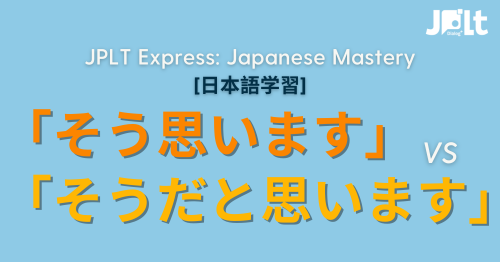What is the difference between “そう思います” (sou omoimasu) and “そうだと思います” (sou da to omoimasu)?
■ “そう思います” (Sou omoimasu)
When sharing your opinion about a movie:
- 「この映画は面白いと思います。」 (Kono eiga wa omoshiroi to omoimasu): I think this movie is interesting.
When stating your opinion in a discussion:
- 「彼のアイデアは素晴らしいと思います。」 (Kare no aidea wa subarashii to omoimasu): I think his idea is great.
■ “そうだと思います” (Sou da to omoimasu)
When responding based on information:
- 「彼は来週出張に行くそうです。」「そうだと思います。」 (Kare wa raishuu shucchou ni iku sou desu. “Sou da to omoimasu”): He is going on a business trip next week. “I think so.”
When agreeing with someone’s opinion:
- 「このプロジェクトは成功する可能性が高いと思います。」「そうだと思います。」 (Kono purojekuto wa seikou suru kanousei ga takai to omoimasu. “Sou da to omoimasu”): I think this project has a high chance of success. “I think so too.”
■ Specific Differences
Subjective vs. Objective:
- “そう思います” expresses your subjective opinion or thought.
- “そうだと思います” expresses agreement with someone else’s opinion or information.
Nuance Differences:
- Personal Opinion: “そう思います” is based on your own feelings.
- Example: 「この絵はとても美しいと思います。」 (Kono e wa totemo utsukushii to omoimasu): I think this painting is very beautiful.
- Agreement with Others: “そうだと思います” shows agreement with others’ opinions or information.
- Example: 「彼女は素晴らしいプレゼンターだと思います。」「そうだと思います。」 (Kanojo wa subarashii purezenta- da to omoimasu. “Sou da to omoimasu”): I think she is an excellent presenter. “I think so too.”
■ Summary
What is the difference between “そう思います” and “そうだと思います”?
After understanding the subtle differences between “そう思います” (sou omoimasu) and “そうだと思います” (sou da to omoimasu), you might be wondering how to apply these concepts to improve your Japanese communication skills. The best way to practice these expressions and others is through engaging lessons that allow you to learn at your own pace, with support from both native Japanese instructors and fellow learners. At JPLT Online School, we provide courses that are not only designed to clarify language points like these but also offer real-world practice, interactive activities, and personalized guidance, ensuring you gain practical conversational skills while deepening your understanding of Japanese. Whether you’re just starting or looking to improve, our flexible and supportive learning environment is here to help you succeed.





